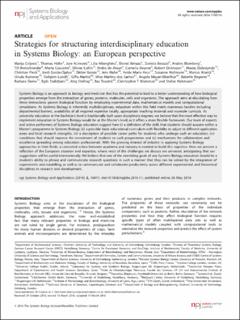| dc.contributor.author | Cvijovic, Marija | |
| dc.contributor.author | Höfer, Thomas | |
| dc.contributor.author | Acimovic, Jure | |
| dc.contributor.author | Alberghina, Lilia | |
| dc.contributor.author | Almaas, Eivind | |
| dc.contributor.author | Besozzi, Daniela | |
| dc.contributor.author | Blomberg, Anders | |
| dc.contributor.author | Bretschneider, Till | |
| dc.contributor.author | Cascante, Marta | |
| dc.contributor.author | Collin, Olivier | |
| dc.contributor.author | de Atauri, Pedro | |
| dc.contributor.author | Depner, Cornelia | |
| dc.contributor.author | Dickinson, Robert | |
| dc.contributor.author | Dobrzynski, Maciej | |
| dc.contributor.author | Fleck, Christian | |
| dc.contributor.author | Garcia-Ojalvo, Jordi | |
| dc.contributor.author | Gonze, Didier | |
| dc.contributor.author | Hahn, Jens | |
| dc.contributor.author | Hess, Heide Marie | |
| dc.contributor.author | Hollmann, Susanne | |
| dc.contributor.author | Krantz, Marcus | |
| dc.contributor.author | Kummer, Ursula | |
| dc.contributor.author | Lundh, torbjorn | |
| dc.contributor.author | Martial, Gifta | |
| dc.contributor.author | Martins dos Santos, Vitor | |
| dc.contributor.author | Mauer-Oberthur, Angela | |
| dc.contributor.author | Regierer, Babette | |
| dc.contributor.author | Skene, Barbara | |
| dc.contributor.author | Stalidzans, Egils | |
| dc.contributor.author | Stelling, Jorg | |
| dc.contributor.author | Teusink, Bas | |
| dc.contributor.author | Workman, Christopher T. | |
| dc.contributor.author | Hohmann, Stefan | |
| dc.date.accessioned | 2020-04-30T13:08:33Z | |
| dc.date.available | 2020-04-30T13:08:33Z | |
| dc.date.created | 2016-11-09T10:29:29Z | |
| dc.date.issued | 2016 | |
| dc.identifier.citation | npj Systems Biology and Applications. 2016, 2 . | en_US |
| dc.identifier.issn | 2056-7189 | |
| dc.identifier.uri | https://hdl.handle.net/11250/2653083 | |
| dc.description.abstract | Systems Biology is an approach to biology and medicine that has the potential to lead to a better understanding of how biological properties emerge from the interaction of genes, proteins, molecules, cells and organisms. The approach aims at elucidating how these interactions govern biological function by employing experimental data, mathematical models and computational simulations. As Systems Biology is inherently multidisciplinary, education within this field meets numerous hurdles including departmental barriers, availability of all required expertise locally, appropriate teaching material and example curricula. As university education at the Bachelor’s level is traditionally built upon disciplinary degrees, we believe that the most effective way to implement education in Systems Biology would be at the Master’s level, as it offers a more flexible framework. Our team of experts and active performers of Systems Biology education suggest here (i) a definition of the skills that students should acquire within a Master’s programme in Systems Biology, (ii) a possible basic educational curriculum with flexibility to adjust to different application areas and local research strengths, (iii) a description of possible career paths for students who undergo such an education, (iv) conditions that should improve the recruitment of students to such programmes and (v) mechanisms for collaboration and excellence spreading among education professionals. With the growing interest of industry in applying Systems Biology approaches in their fields, a concerted action between academia and industry is needed to build this expertise. Here we present a reflection of the European situation and expertise, where most of the challenges we discuss are universal, anticipating that our suggestions will be useful internationally. We believe that one of the overriding goals of any Systems Biology education should be a student’s ability to phrase and communicate research questions in such a manner that they can be solved by the integration of experiments and modelling, as well as to communicate and collaborate productively across different experimental and theoretical disciplines in research and development. | en_US |
| dc.language.iso | eng | en_US |
| dc.publisher | Springer Nature | en_US |
| dc.rights | Navngivelse 4.0 Internasjonal | * |
| dc.rights.uri | http://creativecommons.org/licenses/by/4.0/deed.no | * |
| dc.title | Strategies for structuring interdisciplinary education in Systems Biology: an European perspective | en_US |
| dc.type | Peer reviewed | en_US |
| dc.type | Journal article | en_US |
| dc.description.version | publishedVersion | en_US |
| dc.source.pagenumber | 7 | en_US |
| dc.source.volume | 2 | en_US |
| dc.source.journal | npj Systems Biology and Applications | en_US |
| dc.identifier.doi | 10.1038/npjsba.2016.11 | |
| dc.identifier.cristin | 1398642 | |
| dc.description.localcode | This work is licensed under a Creative Commons Attribution 4.0 International License. The images or other third party material in this article are included in the article’s Creative Commons license, unless indicated otherwise in the credit line; if the material is not included under the Creative Commons license, users will need to obtain permission from the license holder to reproduce the material. To view a copy of this license, visit http://creativecommons.org/licenses/by/4.0/ | en_US |
| cristin.ispublished | true | |
| cristin.fulltext | original | |
| cristin.qualitycode | 1 | |

